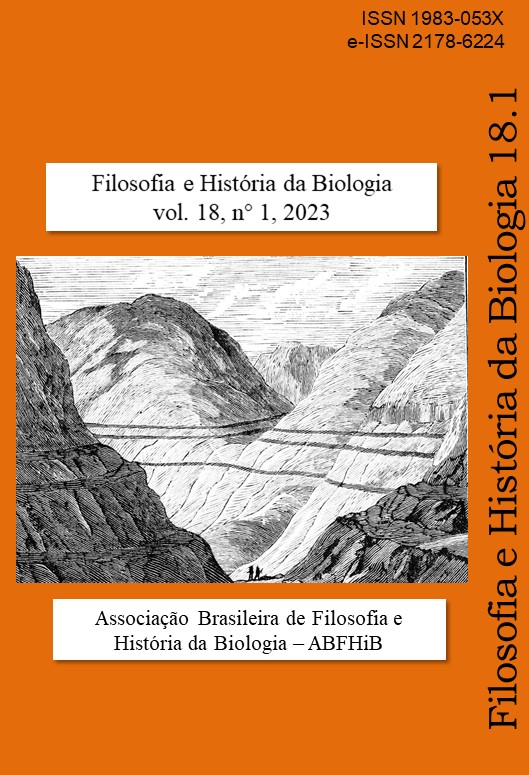Glen Roy’s parallel roads controversy: a justification of Darwin’s procedures
DOI:
https://doi.org/10.11606/issn.2178-6224v18i1p59-72Keywords:
Glen Roy’s parallel roads, Scientific controversies, History of biology, Charles DarwinAbstract
A meaningful philosophical heading for understanding scientific production stands on cognitive expertise; authorities operate as causal agents of specific scientific achievements. Historiography usually pays much attention to bearings that come out of scientific successes. However, the history of biology offers an example in which adherence to cognitive experts resulted in a theoretical failure: the controversy over “the parallel roads of Glen Roy” between Charles Darwin (1809-1882) and the Swiss geologist Louis Agassiz (1807-1873). Darwin, while his investigations, used several cognitive experts such as William Whewell (1794-1866) e Charles Lyell (1797-1875) and considered several hypotheses but denied Agassiz’s one, using the “principle of exclusion”. The purpose of this paper is to show Darwin was justified in doing that, providing his sources, which were flawless authorities in science.
References
BLOOR, David. Conhecimento e imaginário social. Trad. Marcelo do Amaral Penna-Forte. São Paulo: UNESP, 2009.
DARWIN, Charles Robert. Journal of researches into the natural history and geology of the countries visited during the voyage of H.M.S Beagle round the world. New York: D. Appleton and Company, 1873.
DARWIN, Charles Robert. Observations on the parallel roads of Glen Roy, and other parts of Lochaber in Scotland, with an attempt to prove that they are of marine origin. Philosophical Trans-actions of the Royal Society, 129: 39-81, 1839.
DARWIN, Charles Robert. [1887]. Autobiography. BARLOW, Nora (ed). The autobiography of Charles Darwin 1809-1882. London: Collins Clear-Type Press, 1958.
DARWIN, Charles Robert. The variation of animals and plants under domestication. Vol. 2. London: John Murray, 1868.
FARIA, Felipe. Darwin e as Estradas paralelas de Glen Roy. Dis-ponível em: <https://www.researchgate.net/publication/
_Darwin_e_as_Estradas_Paralelas_de_Glen_Roy>. Acesso em: 23 de julho de 2022.
FEYERABEND, Paul. [1975]. Against method. 3 ed. London: Verso, 1993.
HARMAN, Gilbert. Inferência da melhor explicação. Trad. Marcos Rodrigues da Silva; Miriele Sicote de Lima. Dissertatio, 47: 325-332, 2018.
HULL, David. Darwin and his critics: The reception of Darwin’s theory of evolution by the scientific community. Cambridge, MA: Harvard University Press, 1973.
JAMIESON, Thomas. On the parallel roads of Glen Roy, and their place in the history of the glacial period. Quarterly Journal of the Geological Society, 19 (1-2): 235-259, 1863.
KUHN, Thomas. A estrutura das revoluções científicas. Trad. Beatriz Vianna Boeira; Nelson Boeira. 5. Ed. São Paulo: Perspectiva, 2000.
LYELL. Charles. Principles of geology. Vol. 1. 1830.
LAUDER, Thomas Dick. On the parallel roads of Lochaber. Transactions of the Royal Society of Edinburgh, 9: 1-64, 1821.
MACCULLOCH, John. On the parallel roads of Glen Roy. Transactions of the Geological Society of London. 4 (2): 314-391, 1817.
McMULLIN, Ernan. Scientific controversy and its termination. Pp. 49-91, in: ENGELHARDT, Jr.; CAPLAN, A. (eds.). Scientific controversies. Cambridge: Cambridge University Press, 1978.
MILNE, David. XXVII.—On the parallel roads of Lochaber, with remarks on the change of relative levels of sea and land in Scotland, and on the detrital deposits in that country. Earth and Environmental Science Transactions of the Royal Society of Edinburgh, 16 (3), 395-418, 1847.
RUDWICK, Martin. Darwin and Glen Roy: A “great failure” in scientific method? Studies in History and Philosophy of Science. 5 (2): 97-185, 1974.
RUDWICK, Martin. Charles Darwin in London.: the integration of public and private science. Isis, 73 (2): 186-206, 1982. Disponível em: <https://www.jstor.org/stable/231674> Acesso em: 6 de abril de 2023.
RUDWICK, Martin; PALMER, Adrian. The parallel roads of Glen Roy: a field guide, 2009. Disponível em: <https://www.darwinproject.ac.uk/sites/default/files/Rudwick_Glen-Roy-field-guide_DCP.pdf>. Acesso em: 6 de abril de 2023.
SILVA, Marcos Rodrigues; CASTILHO, Daiane Camila. Inferências eliminativas e o problema das alternativas não concebidas. Filosofia Unisinos, 16 (3): 241-255, 2015.
SILVA, Marcos Rodrigues; MINIKOSKI, D. A analogia darwiniana entre seleção artificial e natural e sua dimensão social. Filosofia e História da Biologia, 12 (2): 289-307, 2017.
THAGARD, Paul. A melhor explicação: critérios para a escolha de teorias. Trad. Marcos Rodrigues da Silva. Cognitio, 18 (1): 145-160, 2017.
THAGARD, Paul. Testimony, credibility, and explanatory coherence. Erkenntnis. 63 (3): 295-316, 2005.
WHEWELL, William. The philosophy of the inductive sciences [1840]. Vol. 2. New York: Johnson Reprint, 1967.
ZIMAN, John. O conhecimento confiável. Trad. Tomás R. Bueno. Campinas: Papirus, 1996.
Downloads
Published
Issue
Section
License
Copyright (c) 2023 Filosofia e História da Biologia

This work is licensed under a Creative Commons Attribution-NonCommercial-ShareAlike 4.0 International License.
The published manuscripts become the property of the journal Philosophy and History of Biology, and the authors accept the terms of this license and agree to assign the copyright for publication, in addition to agreeing with the publication's commitment to offering open access to all of its content. The information and concepts issued in signed papers are the sole responsibility of their authors.


 cademia.edu
cademia.edu
